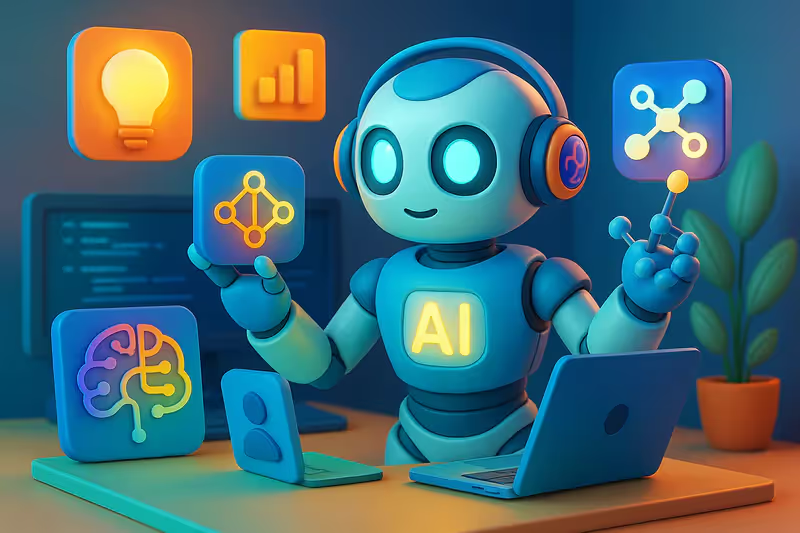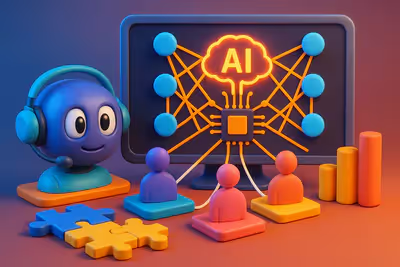Artificial intelligence is changing the way we work. AI agents play an important role in this evolution. These digital assistants analyze data and act to achieve specific goals in a variety of areas.
The numbers speak for themselves: 77% of businesses already use AI in their daily work. By 2026, that number will increase to 90%. The market for AI agents represents 5.1 billion dollars in 2024. It will reach 47.1 billion in 2030, with an increase of 44.8% per year. In banks, these tools will reduce costs by 22% by 2030.
AI Agent Core Technologies

1. Machine Learning
It's like a brain that learns from its experiences. The more cases he sees, the more precise he becomes in his answers in order to function independently.
2. Natural Language Processing (NLP)
This technology allows AI to understand what you say or write. It analyzes your words, your tone, and even your emotions.
3. Neural networks
They function like the neurons in your brain. They connect information to each other to make sense of the data.
A simple example : When you ask “What's the weather like?” , the AI understands that it should check the weather and not the time.
This structure helps businesses:
- Respond to customers more quickly
- Reduce errors
- Work 24 hours a day
- Personalize each interaction
Each technology is constantly improving. Businesses can get started easily and add features as needed.
What are the different types of AI agents and their applications?

AI agents can be classified into several categories according to their complexity and capabilities:
Different types of AI agents are designed to handle various situations based on their complexity and functionality.
Challenges and solutions for AI Agents
The integration of AI agents is transforming businesses, but it also brings its share of challenges. Here is a detailed analysis of the obstacles to overcome and the solutions.
Technical challenges

La compatibility with existing systems remains a major challenge. AI agents need to communicate effectively with tools like SAP or Oracle. This integration often requires significant technical adaptations.
The optimal functioning of AI agents is based on three pillars:
- Of quality data for learning and continuous improvement
- One computing power sufficient to handle complex requests
- Of response time fast to maintain operational efficiency
A critical point to watch out for: hallucinations. Agents can sometimes generate incorrect answers, especially when faced with ambiguous or incomplete data. This risk requires robust audit systems.
Ethical questions

Ethical issues require particular attention:
- Les Algorithmic biases Inherited training data can create discrimination
- The lack of transparency in worried decision-making - 45% of AI models lack ethical oversight
- THEimpact on employment requires to anticipate the training and development of skills
- The question of responsibility is becoming crucial in sensitive sectors such as health
The resolution of these ethical questions requires the establishment of ethics committees and rigorous validation processes.
Safety: an absolute priority

Security is at play on three essential levels:
- La cybersecurity : protect automated processes, especially in finance and in sensitive sectors
- La data protection : ensure strict compliance with GDPR and other regulations
- La defense against attacks : prevent data poisoning and malicious manipulation
To be successful, every business must:
- Train your teams in good security practices
- Implement surveillance protocols
- Update your protection systems regularly
This structured approach to technical, ethical and security challenges allows for the successful integration of AI agents. The key lies in anticipating and implementing solutions adapted to each business context.
Proposed solutions
Integrating AI agents presents complex challenges, but innovative solutions are constantly emerging. By taking a holistic approach that combines solid regulatory frameworks, continuing education, best practices, and technical innovations, businesses can effectively navigate this rapidly changing landscape.
As technology advances, it is important to maintain an open dialogue between developers, users, and regulators to shape a future where AI agents contribute positively to society while minimizing potential risks.
Use cases in various sectors of AI agents
AI agents can be used in a variety of areas to solve complex problems and improve productivity.
Here are some examples of specific practical applications:
Summary and future perspectives
These examples illustrate how AI agents are fundamentally transforming every sector, bringing tangible gains in efficiency, precision, and innovation.
Their versatility and ability to process large amounts of data in real time make them essential tools for businesses looking to remain competitive in a constantly changing world.
By adopting these technologies, organizations can not only optimize their operations, but also create new opportunities for growth and differentiation in their respective markets. However, their integrations also raise significant challenges:
- Ethics and transparency : Ensure that decisions made by AI agents are explainable and consistent with ethical values.
- Data protection : Guarantee the security and confidentiality of the information processed
- Adapting the workforce : Train and retrain employees to work effectively alongside AI agents.
- regulating : Navigating a rapidly changing regulatory landscape regarding the use of AI.
Emerging trends and future innovations

- Collaborative AI agents : Development of agents capable of working in synergy, sharing knowledge and resources to solve complex problems.
- Explainable AI (XAI) : Advances in the creation of AI agents whose decisions are more transparent and understandable for humans.
- Adaptive AI agents : Systems capable of adjusting in real time to changing environments, improving their resilience and efficiency.
- Quantum AI integration : Exploring the potential of quantum computers to create more powerful AI agents capable of solving problems that are currently unsolvable.
- Eco-responsible AI agents : Development of optimized agents to reduce their carbon footprint and promote sustainable practices.
The future of AI agents promises an even deeper integration into our daily lives, with applications that are likely to exceed our current imagination.
Businesses and organizations that know how to anticipate and adapt to these changes will be in the best position to thrive in the economy of tomorrow.
Transforming workflows and decision-making with AI Agents
Les AI agents revolutionize workflows by effectively automating time-consuming administrative tasks , such as the email management And the scheduling meetings .
At the same time, they considerably improve the strategic decision making thanks to the real-time analysis of vast data volumes. For example, in the manufacturing sector, the application of predictive maintenance makes it possible to reduce 50% unplanned downtime , thus optimizing productivity and resources.
The new frontiers of AI: what's changing everything
The AI and connected objects alliance

The marriage between AI and the Internet of Things is redefining our industrial landscape. Experts predict a market of 1.2 trillion dollars by 2030.
Large companies are already showing us the future:
- The smart tractors of John Deere who analyze each plot
- The autonomous factories of siemens Who are self-optimizing
- Machines that make their own decisions
- Systems that predict problems in advance
Data is at the heart of this revolution. Each hectare produces 2.5 terabytes of information. These data allow for precision never before seen in modern agriculture.
A new era for education and agriculture

Education is being transformed with AI. The numbers speak for themselves: 63% of American universities will adopt AI tutors by 2026.
The platform Knewton is already showing impressive results with 94% student satisfaction. Innovations in AI, in particular, are redefining the methods of teaching and learning, making education more accessible and personalized.
In the agricultural sector, the advances are just as spectacular. Tests conducted by TerraTech in Champagne prove that AI can:
- Decrease the use of pesticides of 37%
- Optimizing irrigation
- Predicting crop diseases
- Improving the quality of crops
- Reduce operating costs
The market for vertical farms driven by AI is experiencing an explosive growth of 420% since 2022, according to AGFunder.
More resource-efficient AIs

The new generation of AI is thinking about the environment. The model Gemini Nano Of Google consumes 78% less energy That its competitor GPT-4, while maintaining excellent performance.
Democratization is under way with solutions such as NVIDIA Jetson Edge unto 290 euros. This kit allows any business, regardless of size, to integrate AI into its operations. This accessibility marks a major turning point in the adoption of AI by small and medium-sized businesses.
These advances pave the way for greener and more accessible AI, allowing everyone to participate in this technological revolution without compromising our environment.
Conclusion: The era of AI agents - an unavoidable transition

Les AI agents represent a major advance in intelligent automation, creating new opportunities to transform operations and improve business efficiency. They are redefining performance by automating repetitive processes, optimizing decisions through real-time analytics, and personalizing customer interactions.
The market will reach $47.1 billion by 2030, with a potential economic impact of $15.7 trillion in global GDP. The adoption and implementation of these technologies is becoming a strategic necessity to remain competitive.
Businesses that integrate them now gain a competitive advantage and a better ability to meet market demands.
This transformation requires an approach thoughtful and structured to exploit its potential. Businesses need to invest in Talent training and set up solid governance frameworks. One adapted technological infrastructure remains essential for a successful deployment.

.svg)




